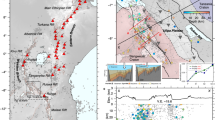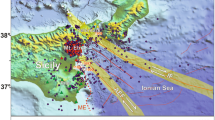Abstract
Buried deep beneath the Antarctic polar ice sheet, the geological structure and tectonic activity of East Antarctica have long remained unknown. The apparent lack of tectonic seismicity was thought to be anomalous relative to other continental interiors and has been attributed to a lack of intraplate stress due to the surrounding spreading ridges and low absolute plate velocity or to the weight of ice sheets increasing the normal stress. Here we report 27 intraplate tectonic earthquakes detected by the AGAP/GAMSEIS seismic array during 2009 in the interior of East Antarctica, which represents locally recorded seismicity in the region. The earthquakes are primarily extensional and located at shallow to mid-crustal depths beneath sedimentary basins aligned linearly adjacent to the Gamburtsev Subglacial Mountains. The basins may be part of an ancient continental rift system, which provides a zone of pre-existing tectonic weakness that focuses the seismicity. These events, when combined with events in published catalogues of Antarctic seismicity, indicate levels of seismicity in East Antarctica of the same order of magnitude as that of other stable cratons, such as the Canadian Shield.
This is a preview of subscription content, access via your institution
Access options
Access Nature and 54 other Nature Portfolio journals
Get Nature+, our best-value online-access subscription
$29.99 / 30 days
cancel any time
Subscribe to this journal
Receive 12 print issues and online access
$259.00 per year
only $21.58 per issue
Buy this article
- Purchase on Springer Link
- Instant access to full article PDF
Prices may be subject to local taxes which are calculated during checkout



Similar content being viewed by others
References
Adams, R. D., Hughes, A. A. & Zhang, B. M. A confirmed earthquake in continental Antarctica. Geophys. J. R. Astron. Soc. 81, 489–492 (1985).
Di Gaicomo, D. et al. A new ISC service: the bibliography of seismic events. Seismol. Res. Lett. 85, 354–360 (2014).
Reading, A. M. in Continental Intraplate Earthquakes: Science, Hazard, and Policy Issues Spec. Paper 425 (eds Stein, S. & Mazzotti, S.) Ch. 18 (Geological Society of America, 2007).
Sykes, L. R. Intraplate seismicity, reactivation of preexisting zones of weakness, alkaline magmatism, and other tectonism postdating continental fragmentation. Rev. Geophys. 16, 621–688 (1978).
DeMets, C., Gordon, R. G., Argus, D. F. & Stein, S. Current plate motions. Geophys. J. Int. 101, 425–478 (1990).
Argus, D. F. & Gordon, R. G. No-net-rotation model of current plate velocities incorporating plate motion model NUVEL-1. Geophys. Res. Lett. 18, 2039–2042 (1991).
Johnston, A. C. Suppression of earthquakes by large continental ice sheets. Nature 330, 467–469 (1987).
Maggi, A., Jackson, J. A., Priestley, K. & Baker, C. A re‐assessment of focal depth distributions in southern Iran, the Tien Shan and northern India: do earthquakes really occur in the continental mantle? Geophys. J. Int. 143, 629–661 (2000).
Snoke, J. A. in International Handbook of Earthquake and Engineering Seismology (eds Lee, W. H. K. et al.) 1629–1630 (Academic, San Diego, 2003).
Guttenberg, B. & Richter, C. F. Frequency of earthquakes in California. Bull. Seismol. Soc. Am. 34, 185–188 (1944).
Frohlich, C. & Davis, S. D. Teleseismic b values; or, much ado about 1.0. J. Geophys. Res. 48, 631–644 (1993).
Okal, E. A. Intraplate seismicity of Antarctica and tectonic implications. Earth. Planet. Sci. Lett. 52, 397–409 (1981).
Ferraccioli, F. et al. East Antarctic rifting triggers uplift of the Gamburtsev Mountains. Nature 479, 338–392 (2011).
Hansen, S. E. et al. Crustal structure of the Gamburtsev Mountains, East Antarctica, from S-wave receiver functions and Rayleigh wave phase velocities. Earth. Planet. Sci. Lett. 300, 395–401 (2010).
Heeszel, D. S. et al. Rayleigh wave constraints on the structure and tectonic history of the Gamburtsev Subglacial Mountains, East Antarctica. J. Geophys. Res. 118, 2138–2153 (2013).
Lloyd, A. J. et al. Upper mantle seismic structure beneath central East Antarctica from body wave tomography: implications for the origin of the Gamburtsev Subglacial Mountains. Geochem. Geophys. Geosyst. 14, 902–920 (2013).
Langston, C. A., Brazier, R., Nyblade, A. A. & Owens, T. J. Local magnitude scale and seismicity rate for Tanzania, East Africa. Bull. Seismol. Soc. Am. 88, 712–721 (1998).
Mulibo, G. D. & Nyblade, A. A. The seismotectonics of southeastern Tanzania: implications for the propagation of the eastern branch of the East African Rift. Tectonophysics 674, 20–30 (2016).
Schulte, S. M. & Mooney, W. D. An updated global earthquake catalogue for stable continental regions: reassessing the correlation with ancient rifts. Geophys. J. Int. 161, 707–721 (2005).
Phillips, G. & Läufer, A. L. Brittle deformation relating to the Carboniferous–Cretaceous evolution of the Lambert Graben, East Antarctica: a precursor for Cenozoic relief development in an intraplate and glaciated region. Tectonophysics 471, 216–224 (2009).
Artyushkov, E. V. Stresses in the lithosphere caused by crustal thickness inhomogeneities. J. Geophys. Res. 78, 7675–7708 (1973).
Pascal, C. & Cloetingh, S. A. P. L. Gravitational potential stresses and stress field of passive continental margins: insights from the south-Norway shelf. Earth Plan. Sci. Lett. 277, 464–473 (2009).
Olivieri, M. & Spada, G. Ice melting and earthquake suppression in Greenland. Polar Sci. 9, 94–106 (2015).
Whitehouse, P. L., Bentley, M. J. & Le Brocq, A. M. A deglacial model for Antarctica: geological constraints and glaciological modelling as a basis for a new model of Antarctic glacial isostatic adjustment. Quat. Sci. Rev. 32, 1–24 (2012).
Martin-Español, A., Bamber, J. L. & Zammit-Mangion, A. Constraining the mass balance of East Antarctica. Geophys. Res. Lett. 44, 4168–4175 (2017).
Arvidsson, R. Fennoscandian earthquakes: whole crustal rupturing related to postglacial rebound. Science 274, 744–746 (1996).
Steffen, R., Wu, P., Steffen, H. & Eaton, D. W. The effect of earth rheology and ice-sheet size on fault slip and magnitude of postglacial earthquakes. Earth Planet. Sci. Lett. 388, 71–80 (2014).
Hubbert, M. K. & Rubey, W. W. Role of fluid pressure in mechanics of overthrust faulting. Bull. Geol. Soc. Am. 70, 115–166 (1959).
Wolovick, M. J., Bell, R. B., Creyts, T. T. & Frearson, N. Identification and control of subglacial water networks under Dome A, Antarctica. J. Geophys. Res. Earth Surf. 118, 140–154 (2013).
Scambos, T., Haran, T., Fahnestock, M., Painter, T. & Bohlander, J. MODIS-based Mosaic of Antarctica (MOA) data sets: continent-wide surface morphology and snow grain size. Remote Sens. Environ. 111, 242–257 (2007).
Fretwell, P. et al. Bedmap2: improved ice bed, surface and thickness datasets for Antarctica. Cryosphere Discuss. 6, 4305–4361 (2012).
Wiens, D. & Nyblade, A. A Broadband Seismic Experiment to Image the Lithosphere beneath the Gamburtsev Mountains, East Antarctica (International Federation of Digital Seismograph Networks, 2007); https://doi.org/10.7914/SN/ZM_2007
Sun, X. et al. Crust and upper mantle shear wave structure of Antarctica from seismic ambient noise. Eos Trans. AGU Fall Meet. Suppl. (AGU, Washington DC, 2009).
Albert, D. G. Theoretical modeling of seismic noise propagation in firn at the South Pole, Antarctica. Geophys. Res. Lett. 25, 4257–4260 (1998).
Kim, W. Y. The M L scale in eastern North America. Bull. Seismol. Soc. Am. 88, 935–951 (1998).
Atkinson, G. M. & Martens, S. N. Seismic hazard estimates for sites in the stable Canadian craton. Can. J. Civil. Eng. 34, 1299–1311 (2007).
Acknowledgements
We thank the polar support specialists at IRIS/PASSCAL, who provided both instrumentation and field support during the operation of this array, and the pilots and staff of Kenn Borek Air and the New York Air National Guard for flight support. We thank the US Antarctic program, its contractors and staff at the South Pole Station, McMurdo Station and AGAP-S camp for logistical support. We also thank the members of the AGAP/GAMSEIS field team, particularly P. Shore, who were essential for gathering this data set. This research was supported by the US National Science Foundation under grants ANT-0537597, ANT-0537371, ANT-0838934, ANT-0838973 and PLR-1246712. Seismic data are available through the IRIS DMC. The facilities of the IRIS Consortium are supported by the NSF under Cooperative Agreement EAR-1063471, the NSF Office of Polar Programs and the DOE National Nuclear Security Administration.
Author information
Authors and Affiliations
Contributions
A.C.L. performed the event location, focal mechanism determination and uncertainty analysis. All the authors participated in the initial data collection, in the interpretation of results and in the preparation of the final paper.
Corresponding author
Ethics declarations
Competing interests
The authors declare no competing interests.
Additional information
Publisher’s note: Springer Nature remains neutral with regard to jurisdictional claims in published maps and institutional affiliations.
Supplementary information
Supplementary Information
Supplementary information
Rights and permissions
About this article
Cite this article
Lough, A.C., Wiens, D.A. & Nyblade, A. Reactivation of ancient Antarctic rift zones by intraplate seismicity. Nature Geosci 11, 515–519 (2018). https://doi.org/10.1038/s41561-018-0140-6
Received:
Accepted:
Published:
Issue Date:
DOI: https://doi.org/10.1038/s41561-018-0140-6
This article is cited by
-
Anomalously high geothermal flux near the South Pole
Scientific Reports (2018)



